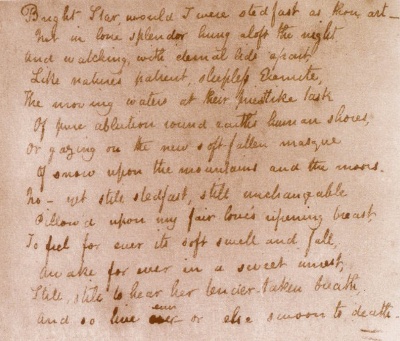John Keats, selected poems Contents
Bright Star! - Language, tone and structure
Language in Bright Star!
The tone changes quite abruptly at the sonnet’s volta, the point where the octave ends and the sestet begins. This would be expected in a Petrarchan sonnet but is less usual in Keats’ chosen structure of Shakespearean sonnet. The purity and steadfastness of the star image turns into the warm sensuousness of physical love with images of ‘love’s ripening breast’ rising and falling.
As Keats states (in lines 10-11) that he would rather be steadfastly pillowed on his lover’s breast (rather than being like the star hanging in splendid isolation in the sky), his choice of language sensuously suggests the physicality for which he yearns: ‘pillowed’ suggests cheeks resting on the plumply swelling breast.
The sounds in ‘soft fall and swell’, the sibilants and the softness of the ‘f’ and ‘sw’ sounds, enact the tenderness of the act of laying his cheek upon the breast.
 Investigating language and tone in Bright Star!
Investigating language and tone in Bright Star!
- How do you react to the speaker’s desire to feel ‘for ever’ the rise and fall of his love’s breast?
- Does the hyperbole convey passion or is it merely ridiculous?
- How does Keats use sound in this poem to create its effects?
- Explain how the tone changes between the octave and the sestet.
- What does the language suggest is attractive about the star – and what are its limitations?
Structure and versification in Bright Star!
This Shakespearean sonnet is constructed around the contrast of cold isolation and warm communion. The octave focuses on the image of the ‘bright star’, traditionally an image of permanence, which has its appeal when considering enduring love. However, the personified star is rejected as the sonnet moves into the sestet. This turn (or volta) is indicated by the emphatic word ‘No’.
From this point onwards the sonnet becomes much warmer in tone and language as the speaker paints an erotic image of himself pillowed on his lover’s breast.
Investigating structure and versification in Bright Star!
- What is the relationship between the two parts of the sonnet (i.e. the octave and the sestet)?
- Explain the effect of the word ‘No’ which comes at the turn between the two sections.
- What is the effect of the enjambement between lines 2 and 3 and between lines 5 and 6?
The tone of voice in which anything is to be read in: e.g. lyrical, dramatic, contemplative.
Often the volta introduces a shift in tone as the speaker moves from uncertainty to resolution and voices a change in his or her ideas or plans.
The 8-line stanza of a Petrarchan sonnet, always occupying the first eight lines. It sometimes has a division halfway, creating two quatrains. It poses a problem or describes some single object or incident.
The 6-line stanza of a Petrarchan sonnet, occupying the last six lines, sometimes divided into tercets or couplets. It often resolves the problem posed in the octave or comments significantly on it.
A form of sonnet developed by the poet Petrarch.
A form of sonnet developed by William Shakespeare
Making a hissing sound
A figure of speech denoting exaggeration.
Represented or imagined as a person.
The technique used in blank verse and other verse forms in which the sense of a line runs on without a pause to the next one; this often gives a sense of greater fluency to the lines.
Recently Viewed
-
John Keats, selected poems » Bright Star! - Language, tone and structure
now -
A-Z: General definitions » King Lear
just now -
John Keats, selected poems » Paradoxical life
just now -
John Keats, selected poems » O Solitude, if I must with thee dwell: Synopsis and commentary
just now -
John Keats, selected poems » The Eve of St Agnes - Synopsis and commentary
just now -
John Keats, selected poems » To Mrs Reynolds’s Cat: Synopsis and commentary
just now -
John Keats, selected poems » Keats’ literary career
just now -
A-Z: General definitions » Cupid
just now -
John Keats, selected poems » To Mrs Reynolds’s Cat: Language, tone and structure
just now -
John Keats, selected poems » Ode to Psyche: Language, tone and structure
just now -
John Keats, selected poems » Ode on Indolence: Language, tone and structure
just now -
John Keats, selected poems » Lamia: Language, tone and structure
just now -
John Keats, selected poems » The Eve of St Agnes - Language, tone and structure
just now -
A-Z: General definitions » Theologian
just now -
John Keats, selected poems » On Seeing the Elgin Marbles: Language, tone and structure
just now -
John Keats, selected poems » Revolution and war
just now
Related material
Scan and go

Scan on your mobile for direct link.